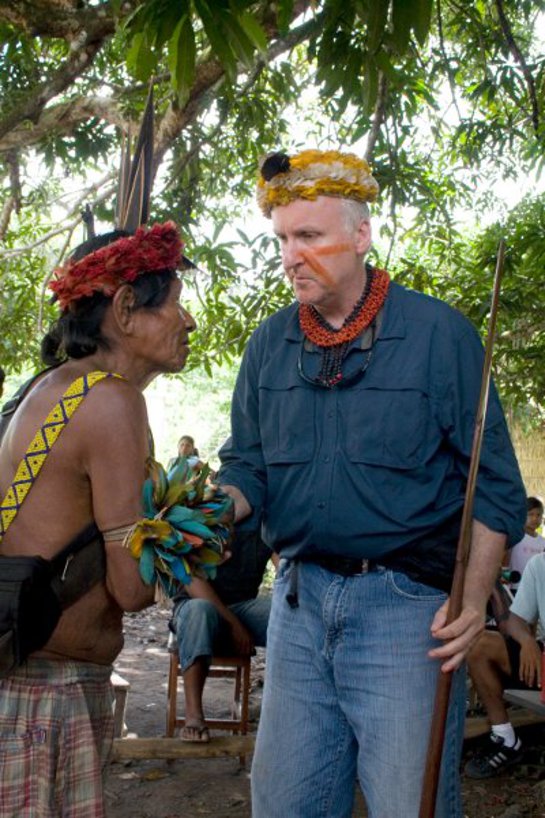Belo Monte – Indians threaten “river of blood”
By Sue Branford
President Lula has never wavered in his support for the huge and controversial Belo Monte hydroelectric power station on the Xingu river in the Amazon basin. Referring to the judicial attempts to get it stopped for failing to observe Brazil’s environmental legislation, he said unequivocally that he would get it off the ground “na lei ou na marra” [by legal means or by force].
In the short term, at least, President Lula has got what he wanted. On 20 April 2010 a contract was signed with a consortium of construction companies, and work should begin in September. But the battle is far from over. The project is mired in environmental and judicial controversies, and a group of Indians has warned that they will wage war if the project goes ahead, turning the Xingu into a “river of blood”.
There has been fierce debate over Belo Monte for more than 30 years. In 1979 a study carried out by the military government then in power proposed the construction of five hydroelectric power stations along the Xingu river (with another along the Iriri river). One of them was Belo Monte, then called Kararao. But the construction of these dams was postponed in the wake of the uproar over the building of the giant Itaipu dam on the border with Paraguay, which led to the eviction of thousands of people and to the flooding of one of Brazil’s most important nature reserves, Sete Quedas.
Brazil’s first civilian president, José Sarney, tried to revive the project. But indigenous groups learnt that 1,600 sq. kms of land would be  flooded, 85% of it in indigenous territory. Led by the Kayapó, renowned for their warrior traditions, the Indians formed an alliance, called the Peoples of the Xingu, to organise opposition. For five days more than 600 Kayapó and members of other indigenous tribes took over the town of Altamira (where the state energy company, Eletronorte, has its offices), transforming it into an Indian village. Sting and other celebrities came to Brazil to express their support. There was no real violence, but a dramatic picture of an indigenous Kayapó woman, Tuira, threatening the president of Eletronorte with a knife, found its way into many international newspapers (see left). The indigenous leader Paulo Payakan flew to Washington in a highly publicised trip to protest to the World Bank about its involvement in the project. Sarney backed off, shelving the project.
flooded, 85% of it in indigenous territory. Led by the Kayapó, renowned for their warrior traditions, the Indians formed an alliance, called the Peoples of the Xingu, to organise opposition. For five days more than 600 Kayapó and members of other indigenous tribes took over the town of Altamira (where the state energy company, Eletronorte, has its offices), transforming it into an Indian village. Sting and other celebrities came to Brazil to express their support. There was no real violence, but a dramatic picture of an indigenous Kayapó woman, Tuira, threatening the president of Eletronorte with a knife, found its way into many international newspapers (see left). The indigenous leader Paulo Payakan flew to Washington in a highly publicised trip to protest to the World Bank about its involvement in the project. Sarney backed off, shelving the project.
Project revived
Thirteen years later the project was revived by the government of President Fernando Henrique Cardoso, which introduced radical changes. The number of power stations was reduced from five to one, and the indigenous name of the surviving dam – Kararao – was changed to the more innocuous-sounding Belo Monte. The area to be flooded was reduced to 500 sq. kms – still vast. If completed, Belo Monte, with an installed capacity of 11,200 megawatts, will be the third largest hydroelectric dam in the world (after China’s Three Gorges Dam and Itaipu).
But once again the project is facing resistance of all kinds. Today Brazil has a fairly effective system of independent public prosecutors, whose role, established in the post-dictatorship 1985 constitution, is precisely to defend the interests of ordinary citizens against the power of big economic groups and the state. Time and again these prosecutors have blocked the project, as environmental and indigenous organisations have pointed to the government’s failure to carry out proper environmental impact studies.
Indeed, it was doubtful until the very last minute whether the bid for the construction deal would go ahead as planned on 20th April, because earlier in the month Antônio Carlos Campelo, the federal judge of Altamira, ruled that the bid could not go ahead, after a scrupulous investigation revealed various irregularities in the way the environmental licence had been conducted. In the end, a high court judge, Jirair Meguerian, widely reported to have been leant on heavily by the government, reversed the ruling and gave the go-ahead (though he did not refute any of the points raised by Campelo).
 This time round there is no foreign money involved, so there will be no trips to Washington. International environmental organisations have protested and the filmmaker James Cameron, who directly the hugely successful ‘Avatar’, took part in a recent indigenous demonstration in Brazil. All are vulnerable, however, to accusations from the Brazilian government that they are meddling in a domestic controversy.
This time round there is no foreign money involved, so there will be no trips to Washington. International environmental organisations have protested and the filmmaker James Cameron, who directly the hugely successful ‘Avatar’, took part in a recent indigenous demonstration in Brazil. All are vulnerable, however, to accusations from the Brazilian government that they are meddling in a domestic controversy.
The wrangling in Brazil promises to be fierce. The public prosecutors are fighting back and have already lodged 13 appeals against the last-minute ruling made by Meguerian. One of their strongest arguments is that the authorisation for the dam infringes article 176 of the Constitution, which demands special legislation before a hydroelectric dam can be built on indigenous land. The prosecutors are arguing that, even though the dam itself is not located on indigenous land, it will seriously affect the Xingu river that runs through indigenous land. Eletronorte claims that the article applies only to dams actually built on indigenous reserves. It is clear that the legal arguments will run and run …
Even the bidding process itself was far from smooth. Most of Brazil’s heavyweight construction companies, like Odebrecht and Camargo Corrêa, decided to pull out (although they are still willing to work as sub-contractors). A last-minute alliance, formed by the construction company Quieroz Galvão and the meat-packing Bertin group, put in an unexpectedly low bid and won. There has been much speculation in the Brazilian press that the winning consortium was attracted by the extremely low rates of interest to be charged by Brazil’s state-owned development bank, BNDES (which is providing 80% of the financing), and has received unofficial assurances from the government that additional subsidies will be provided, should the construction costs prove higher than budgeted.
In fact, the budget could well rise. The construction of Belo Monte will require the digging of two channels, each 35 kms long and 500m wide. Some 160 million cubic metres of earth and 60 million cubic metres of rocks will have to be dug out – more than was moved to build the Panama Canal. Moreover, the land lies precisely at the meeting of two different geological formations – the alluvial lands of the Amazon basin and the central plateau of Brazil. Some geologists fear that this could mean that the terrain is unstable.
Host of problems
There are a host of other problems. Seasonal variations in the level of water in the Xingu river means that it almost certainly will have to operate at well under half its installed capacity. Environmentalists have pointed to the social cost, saying that the dam will seriously disrupt the lives of many people in the region, most of whom depend on fishing for their livelihoods. Most of the energy will be supplied at heavily subsidised rates to energy-intensive extractive industries, such as aluminium smelting and pig-iron production, whose product is largely exported. Local people will get little benefit.
A few days after the bidding, Afonso Henriques Moreira Santos, a former director of Brazil’s electricity regulatory agency Aneel, unexpectedly accused the government of creating a “monster” in the electricity sector. He said that it was rash to be carrying on building huge power stations, which d epended on very long transmission lines, which are both costly and vulnerable to breakdown, for the distribution of its energy. He said that it would be much wiser to be using alternatives, such as natural gas from the Bay of Santos or solar energy. Huge savings could also be made, he said, by making the existing system much less wasteful.
epended on very long transmission lines, which are both costly and vulnerable to breakdown, for the distribution of its energy. He said that it would be much wiser to be using alternatives, such as natural gas from the Bay of Santos or solar energy. Huge savings could also be made, he said, by making the existing system much less wasteful.
Other environmentalists and scientists are scared by the risks the government is taking with the country’s long-term future. They believe that, with about a quarter of the forest already felled, the Amazon forest is dangerously near a tipping point at which rainfall patterns will be permanently disrupted and the forest will start drying out, with catastrophic consequences for the climate of Brazil and other South American countries. “Belo Monte represents an out-dated Brazil, imprisoned to old energy models that benefit few but possess an enormous capacity for social and environmental destruction”, said Beatriz Carvalho, assistant campaigns director for Greanpeace. “At the heart of the discussion about Belo Monte lies the fundamental question: what model of development do we want for Brazil, today and in future decades.”
Such arguments have little weight with President Lula. Brought up in Sao Paulo, he has never shown any sympathy for the environmental cause. His over-riding ambitious is to turn Brazil into a world power as quickly as possible. Justifying his decision to back Belo Monte, he said recently to journalists: “A country that wants to be the fifth-biggest economy on the planet within the next decade … needs to think five years ahead. That is why we are doing this.”
As ever, the strongest opposition to the dam is likely to come from the indigenous communities. Some Indians have already been arriving in Altamira covered in warpaint (see picture), but they are likely to take time before they decide on what action to take. We can be sure, however, that the confrontation will be fierce.
